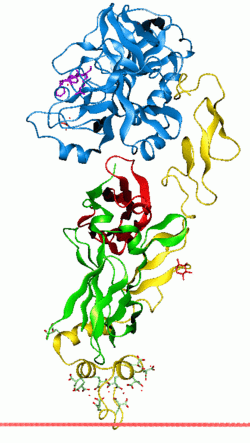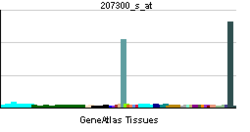- Factor VII
-
Factor VII (formerly known as proconvertin) is one of the proteins that causes blood to clot in the coagulation cascade. It is an enzyme (EC 3.4.21.21) of the serine protease class. A recombinant form of human factor VIIa (NovoSeven, eptacog alfa [activated]) has U.S. Food and Drug Administration approval for uncontrolled bleeding in hemophilia patients. It is often used unlicensed in severe uncontrollable bleeding, although there has been safety concerns.
Contents
Physiology
The main role of factor VII (FVII) is to initiate the process of coagulation in conjunction with tissue factor (TF/factor III). Tissue factor is found on the outside of blood vessels - normally not exposed to the bloodstream. Upon vessel injury, tissue factor is exposed to the blood and circulating factor VII. Once bound to TF, FVII is activated to FVIIa by different proteases, among which are thrombin (factor IIa), factor Xa, IXa, XIIa, and the FVIIa-TF complex itself. The most important substrates for FVIIa-TF are Factor X and Factor IX.
The action of the factor is impeded by tissue factor pathway inhibitor (TFPI), which is released almost immediately after initiation of coagulation. Factor VII is vitamin K dependent; it is produced in the liver. Use of warfarin or similar anticoagulants decreases hepatic synthesis of FVII.
Genetics
The gene for factor VII is located on chromosome 13 (13q34).
Role in disease
Deficiency is rare (congenital proconvertin deficiency) and inherits recessively. Factor VII deficiency presents as a hemophilia-like bleeding disorder. It is treated with recombinant factor VIIa (NovoSeven).
Therapeutic use
Recombinant human factor VIIa (NovoSeven, eptacog alfa [activated], ATC code B02BD08) has been introduced for use in uncontrollable bleeding in hemophilia patients (with Factor VIII or IX deficiency) who have developed inhibitors against replacement coagulation factor.
It is being increasingly used in uncontrollable hemorrhage.[1] The first report of its use was in an Israeli soldier with uncontrollable bleeding in 1999.[2] The rationale for its use in hemorrhage is, that it will only induce coagulation in those sites where tissue factor (TF) is also present. Still, O'Connell et al. report an increased risk of deep vein thrombosis, pulmonary embolism and myocardial infarction in association with the use of rhFVIIa.[3] A 2008 meta-analysis of randomized controlled trials of of rhFVIIa in patients without hemophilia showed no additional risk of deep vein thrombosis or pulmonary embolism and the risk of arterial thrombosis to be substantially less than the potential to reduce mortality.[4] In 2010 a larger study combining the results 35 trials showed a definite increase in arterial thrombosis, the risk of which was higher in older patients.[5]
According to a 2005 study, recombinant human factor VII improves outcomes in acute intracerebral hemorrhage.,[6] but a more recent, larger 2008 study by the same group to address these initial findings failed to show any mortality benefit. Factor VII is no longer recommended in the treatment of patients with intracerebral hemorrhage.[7]
Interactions
Factor VII has been shown to interact with Tissue factor.[8][9]
References
- ^ Roberts H, Monroe D, White G (2004). "The use of recombinant factor VIIa in the treatment of bleeding disorders". Blood 104 (13): 3858–64. doi:10.1182/blood-2004-06-2223. PMID 15328151.
- ^ Kenet G, Walden R, Eldad A, Martinowitz U (1999). "Treatment of traumatic bleeding with recombinant factor VIIa". Lancet 354 (9193): 1879. doi:10.1016/S0140-6736(99)05155-7. PMID 10584732.
- ^ O'Connell K, Wood J, Wise R, Lozier J, Braun M (2006). "Thromboembolic adverse events after use of recombinant human coagulation factor VIIa". JAMA 295 (3): 293–8. doi:10.1001/jama.295.3.293. PMID 16418464.
- ^ Hsia CC, Chin-Yee IH, McAlister VC (July 2008). "Use of recombinant activated factor VII in patients without hemophilia: a meta-analysis of randomized control trials". Ann. Surg. 248 (1): 61–8. doi:10.1097/SLA.0b013e318176c4ec. PMID 18580208.
- ^ Levi M, Levy JH, Andersen HF, Truloff D (November 2010). "Safety of recombinant activated factor VII in randomized clinical trials". N. Engl. J. Med. 363 (19): 1791–800. doi:10.1056/NEJMoa1006221. PMID 21047223.
- ^ Mayer S, Brun N, Begtrup K, Broderick J, Davis S, Diringer M, Skolnick B, Steiner T (2005). "Recombinant activated factor VII for acute intracerebral hemorrhage". N. Engl. J. Med. 352 (8): 777–85. doi:10.1056/NEJMoa042991. PMID 15728810.
- ^ Mayer SA, Brun NC, Begtrup K, et al. (May 2008). "Efficacy and safety of recombinant activated factor VII for acute intracerebral hemorrhage". N. Engl. J. Med. 358 (20): 2127–37. doi:10.1056/NEJMoa0707534. PMID 18480205. http://www.nejm.org/doi/full/10.1056/NEJMoa0707534.
- ^ Carlsson, Karin; Freskgård Per-Ola, Persson Egon, Carlsson Uno, Svensson Magdalena (Jun. 2003). "Probing the interface between factor Xa and tissue factor in the quaternary complex tissue factor-factor VIIa-factor Xa-tissue factor pathway inhibitor". Eur. J. Biochem. (Germany) 270 (12): 2576–82. doi:10.1046/j.1432-1033.2003.03625.x. ISSN 0014-2956. PMID 12787023.
- ^ Zhang, E; St Charles R, Tulinsky A (Feb. 1999). "Structure of extracellular tissue factor complexed with factor VIIa inhibited with a BPTI mutant". J. Mol. Biol. (ENGLAND) 285 (5): 2089–104. doi:10.1006/jmbi.1998.2452. ISSN 0022-2836. PMID 9925787.
External links
- The MEROPS online database for peptidases and their inhibitors: S01.215
- Web site for novoseven-us.com
Further reading
- Broze GJ Jr, Majerus PW (1980). "Purification and properties of human coagulation factor VII". J. Biol. Chem. 255 (4): 1242–7. PMID 7354023.
- Versteeg HH, Peppelenbosch MP, Spek CA (2002). "The pleiotropic effects of tissue factor: a possible role for factor VIIa-induced intracellular signalling?". Thromb. Haemost. 86 (6): 1353–9. PMID 11776298.
- Golino P (2003). "The inhibitors of the tissue factor:factor VII pathway". Thromb. Res. 106 (3): V257–65. doi:10.1016/S0049-3848(02)00079-8. PMID 12356487.
PDB gallery {{Gallery |lines=4 |Image:PDB_1bf9_EBI.jpg|1bf9: N-TERMINAL EGF-LIKE DOMAIN FROM HUMAN FACTOR VII, NMR, 23 STRUCTURES |Image:PDB_1cvw_EBI.jpg|1cvw: CRYSTAL STRUCTURE OF ACTIVE SITE-INHIBITED HUMAN COAGULATION FACTOR VIIA (DES-GLA) |Image:PDB_1dan_EBI.jpg|1dan: COMPLEX OF ACTIVE SITE INHIBITED HUMAN BLOOD COAGULATION FACTOR VIIA WITH HUMAN RECOMBINANT SOLUBLE TISSUE FACTOR |Image:PDB_1dva_EBI.jpg|1dva: Crystal Structure of the Complex Between the Peptide Exosite Inhibitor E-76 and Coagulation Factor VIIA |Image:PDB_1f7e_EBI.jpg|1f7e: THE FIRST EGF-LIKE DOMAIN FROM HUMAN BLOOD COAGULATION FVII, NMR, 20 STRUCTURES |Image:PDB_1f7m_EBI.jpg|1f7m: THE FIRST EGF-LIKE DOMAIN FROM HUMAN BLOOD COAGULATION FVII, NMR, MINIMIZED AVERAGE STRUCTURE |Image:PDB_1fak_EBI.jpg|1fak: HUMAN TISSUE FACTOR COMPLEXED WITH COAGULATION FACTOR VIIA INHIBITED WITH A BPTI-MUTANT |Image:PDB_1ff7_EBI.jpg|1ff7: THE FIRST EGF-LIKE DOMAIN FROM HUMAN BLOOD COAGULATION FVII (FUCOSYLATED AT SER-60), NMR, 20 STRUCTURES |Image:PDB_1ffm_EBI.jpg|1ffm: THE FIRST EGF-LIKE DOMAIN FROM HUMAN BLOOD COAGULATION FVII (FUCOSYLATED AT SER-60), NMR, MINIMIZED AVERAGE STRUCTURE |Image:PDB_1j9c_EBI.jpg|1j9c: Crystal Structure of tissue factor-factor VIIa complex |Image:PDB_1jbu_EBI.jpg|1jbu: Coagulation Factor VII Zymogen (EGF2/Protease) in Complex with Inhibitory Exosite Peptide A-183 |Image:PDB_1kli_EBI.jpg|1kli: Cofactor-and substrate-assisted activation of factor VIIa |Image:PDB_1klj_EBI.jpg|1klj: Crystal structure of uninhibited factor VIIa |Image:PDB_1o5d_EBI.jpg|1o5d: Dissecting and Designing Inhibitor Selectivity Determinants at the S1 site Using an Artificial Ala190 Protease (Ala190 uPA) |Image:PDB_1qfk_EBI.jpg|1qfk: STRUCTURE OF HUMAN FACTOR VIIA AND ITS IMPLICATIONS FOR THE TRIGGERING OF BLOOD COAGULATION |Image:PDB_1w0y_EBI.jpg|1w0y: TF7A_3771 COMPLEX |Image:PDB_1w2k_EBI.jpg|1w2k: TF7A_4380 COMPLEX |Image:PDB_1w7x_EBI.jpg|1w7x: FACTOR7- 413 COMPLEX |Image:PDB_1w8b_EBI.jpg|1w8b: FACTOR7 - 413 COMPLEX |Image:PDB_1wqv_EBI.jpg|1wqv: Human Factor Viia-Tissue Factor Complexed with propylsulfonamide-D-Thr-Met-p-aminobenzamidine |Image:PDB_1wss_EBI.jpg|1wss: Human Factor Viia-Tissue Factor in Complex with peprid mimetic inhibitor that has two charge groups in P2 and P4 |Image:PDB_1wtg_EBI.jpg|1wtg: Human Factor Viia-Tissue Factor Complexed with ethylsulfonamide-D-biphenylalanine-Gln-p-aminobenzamidine |Image:PDB_1wun_EBI.jpg|1wun: Human Factor Viia-Tissue Factor Complexed with ethylsulfonamide-D-Trp-Gln-p-aminobenzamidine |Image:PDB_1wv7_EBI.jpg|1wv7: Human Factor Viia-Tissue Factor Complexed with ethylsulfonamide-D-5-propoxy-Trp-Gln-p-aminobenzamidine |Image:PDB_1ygc_EBI.jpg|1ygc: Short Factor VIIa with a small molecule inhibitor |Image:PDB_1z6j_EBI.jpg|1z6j: Crystal Structure of a ternary complex of Factor VIIa/Tissue Factor/Pyrazinone Inhibitor |Image:PDB_2a2q_EBI.jpg|2a2q: Complex of Active-site Inhibited Human Coagulation Factor VIIa with Human Soluble Tissue Factor in the Presence of Ca2+, Mg2+, Na+, and Zn2+ |Image:PDB_2aei_EBI.jpg|2aei: Crystal structure of a ternary complex of factor VIIa/tissue factor and 2-[[6-[3-(aminoiminomethyl)phenoxy]-3,5-difluro-4-[(1-methyl-3-phenylpropyl)amino]-2-pyridinyl]oxy]-benzoic acid |Image:PDB_2aer_EBI.jpg|2aer: Crystal Structure of Benzamidine-Factor VIIa/Soluble Tissue Factor complex. |Image:PDB_2b7d_EBI.jpg|2b7d: Factor VIIa Inhibitors: Chemical Optimization, Preclinical Pharmacokinetics, Pharmacodynamics, and Efficacy in a Baboon Thrombosis Model |Image:PDB_2b8o_EBI.jpg|2b8o: Crystal Structure of Glu-Gly-Arg-Chloromethyl Ketone-Factor VIIa/Soluble Tissue Factor Complex |Image:PDB_2bz6_EBI.jpg|2bz6: ORALLY AVAILABLE FACTOR7A INHIBITOR |Image:PDB_2c4f_EBI.jpg|2c4f: CRYSTAL STRUCTURE OF FACTOR VII.STF COMPLEXED WITH PD0297121 |Image:PDB_2f9b_EBI.jpg|2f9b: Discovery of Novel Heterocyclic Factor VIIa Inhibitors |Image:PDB_2fir_EBI.jpg|2fir: Crystal structure of DFPR-VIIa/sTF |Image:PDB_2flb_EBI.jpg|2flb: Discovery of a Novel Hydroxy Pyrazole Based Factor IXa Inhibitor |Image:PDB_2flr_EBI.jpg|2flr: Novel 5-Azaindole Factor VIIa Inhibitors |Image:PDB_2puq_EBI.jpg|2puq: Crystal structure of active site inhibited coagulation factor VIIA in complex with soluble tissue factor
}}Proteins: coagulation Coagulation factors III "Tissue factor" · VIICoagulation inhibitors Thrombolysis/fibrinolysis Categories:- Human proteins
- Coagulation system
- EC 3.4.21
- Peripheral membrane proteins
Wikimedia Foundation. 2010.


